Danielle Major is one of those rare and gifted all-around students who defied the odds from an early age. She is an exceptional academic all-star athlete, and student coach. In short, she excels in, well, everything.
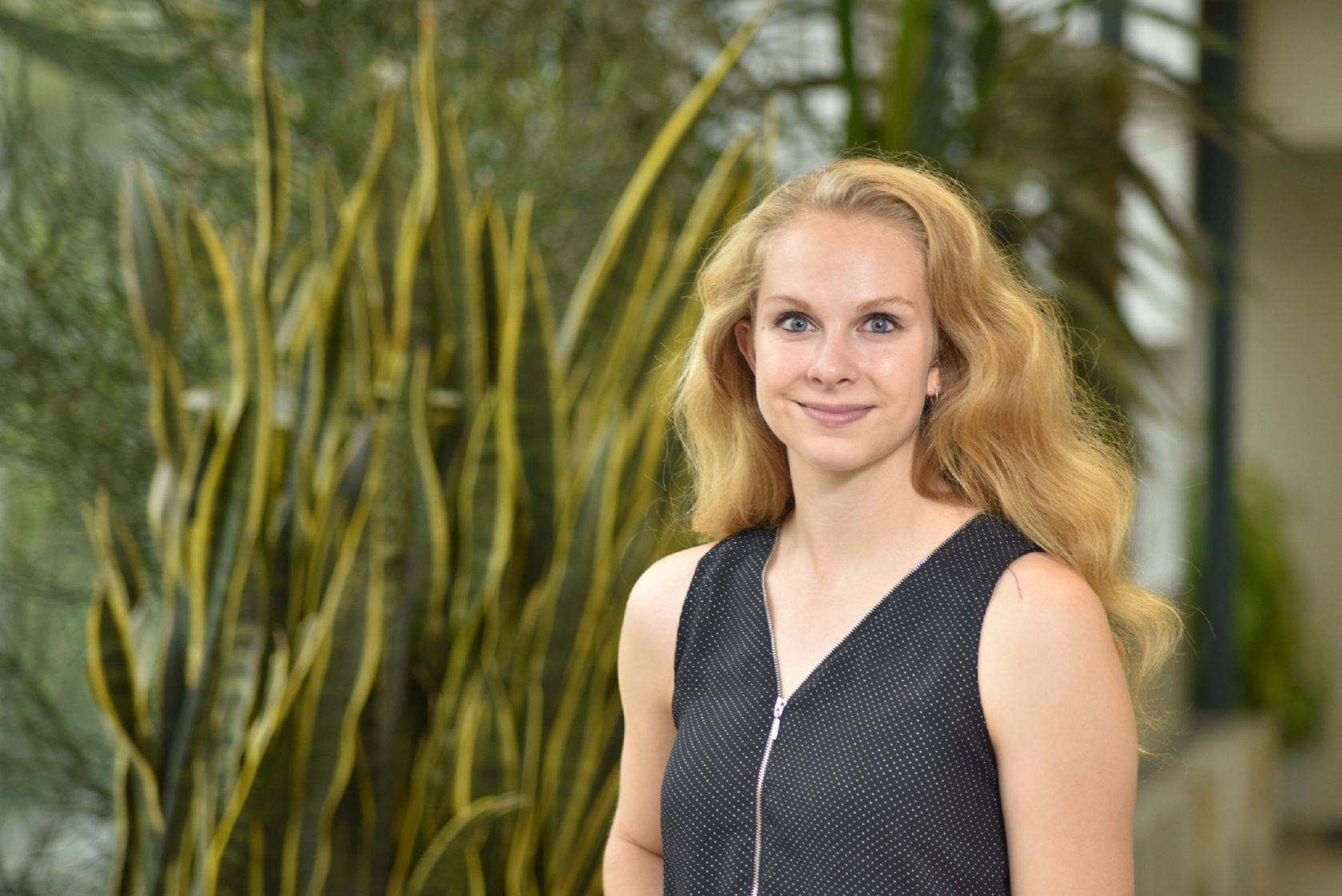
The sun peeks through an ever-changing Fall sky as the last of October’s leaves hold on to their branches, waiting for the next gust of wind to take flight.
While many of her University of Regina Kinesiology peers have gone home to rest and recharge for the Thanksgiving Weekend, 22-year-old Danielle Major has her hands full on her parent’s first-generation cattle farm, located just outside of St. Brieux in Central Saskatchewan. Danielle calmly reassures a nervous Black Angus calf, temporarily immobilized in a steel headgate, that the ear tagging, vaccinations, and humane castration procedure that are about to occur will be over soon.
The majestic animal seems to sense the young woman’s competence and gentle resolve, and the calf settles under Danielle’s coaxing.
“Danielle has always had an affinity for the farm and for the animals,” mom Lisa says proudly. “When she was a little girl, she’d rush home from school if we had an orphaned calf and bottle feed it until it was able to fend for itself. That’s just Danielle. Out of all of my four girls (Danielle being the youngest), she takes after her dad the most. She drives the skid steer, moves the bales, and does whatever she can to help out with the herd (numbering about 100 head of cattle and 100 calves this year).”
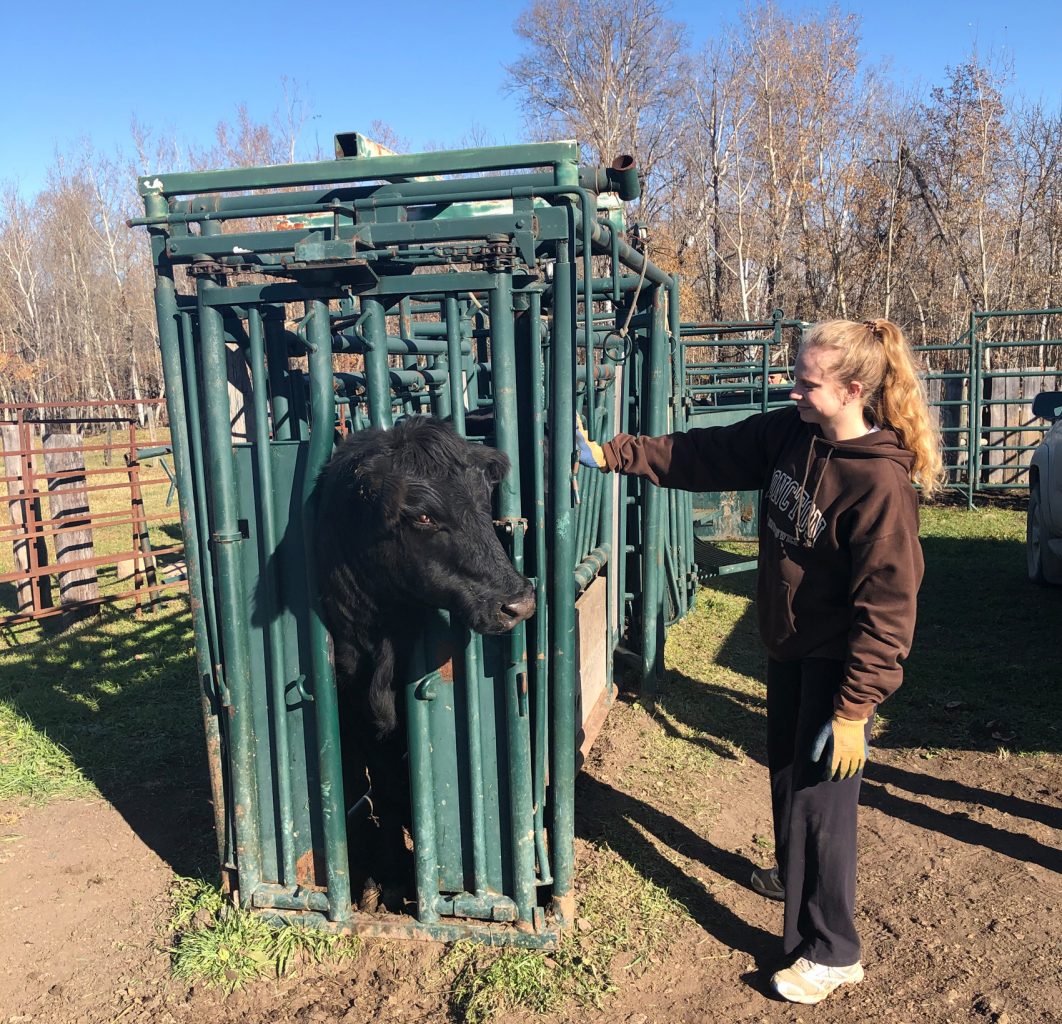
The annual calf roundup is a huge event on the Major farm, and it’s all-hands-on deck for Danielle and her next oldest sister Katelyn, 26, a U of R Honours History grad who works as a student recruiter. The two sisters live together in a Regina condo that once belonged to their grandmother and have driven up for the long weekend. So has their eldest sister Larissa, 32, a U of R Education grad, teacher, and former nurse, who has come from Coronach with her husband Brandon and their little boy, Bennett – the first grandchild for Charlie and Lisa Major, and the first boy in the family. The only sister missing from the family gathering is 29-year-old Ashley, a U of R Human Justice grad and international lawyer in Toronto, who was unable to get away for the weekend. While her presence is certainly missed this Thanksgiving, she is definitely there in spirit as the rest of the sisters get to work for the annual roundup. Even little Bennett gets in on the action.
While Larissa admits that her young son is doted upon by his grandparents and aunties, their dad Charlie never missed out by having four daughters because Danielle was always his right hand.
“My sisters and I were not exactly excited to have to deal with the cows, but Danielle was always in her element,” Larissa recalls. “She’s the one who loved to spend time with Dad hunting for and tending to the cattle. We always thought she was going to be a vet and we called her Dr. Danielle, but here she is about to graduate next year with her heart set on medical school – a doctor of people and not animals.”
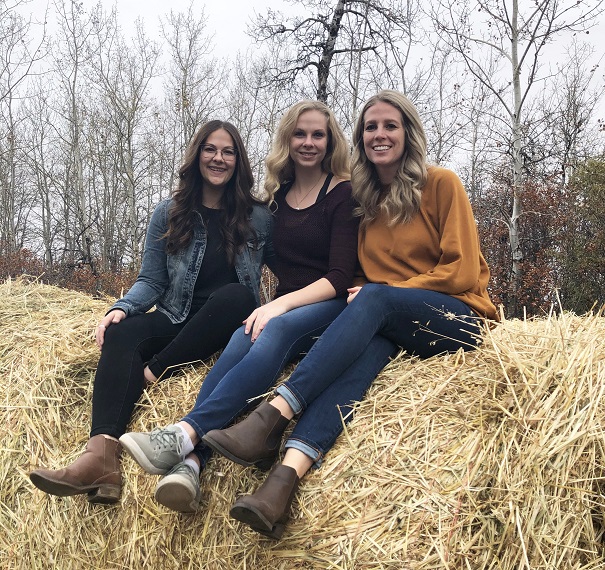
Danielle is one of those rare and gifted all-around students who defied the odds even from an early age. She was an all-star high school athlete and student coach, excelling in everything, including basketball, volleyball, track and field, and softball. She volunteered in a long-term care home and vet clinic, was a group leader at vacation Bible camp, and graduated high school with an almost unheard of 99.2 percent entrance average.
“If I can inspire other young women to pursue their education and reach for their own dreams, then I want to do it.”
“My writing has always been fairly proficient with strong English skills, but I would always go for extra help after class,” she begins, her intense blue eyes focused and direct. “When our principal retired, I got him to tutor me because I knew that if my grades were good enough I could obtain scholarships. That was important to me because there wasn’t a lot of money growing up on the farm.”

Danielle is now in her fifth year of Kinesiology – having extended her undergraduate degree by a year so she could excel at hurdles on the U of R track team, which involved training five days per week, lifting weights, and all the while keeping an 80-plus average in all of her hard-core science classes and labs. She currently works at the university’s Fitness and Lifestyle Centre; acts as teacher assistant and lab instructor; volunteers at the Dr. Paul Schwann Centre assisting at-risk cardiac and stroke patients and those with diabetic complications; is an active member of the Kinesiology and Health Studies Students Society; and, volunteers at a student-run health clinic in Regina’s poorest neighbourhood in North Central.
“It can be quite a culture shock when you see people who are the poorest of the poor, struggling with life’s many challenges. It makes you appreciate everything you have and it makes you want to serve,” she says thoughtfully. “I love making a difference, and spending time at SEARCH (an acronym for Student Energies in Action Regina Health), which allows me to give back in such a meaningful way. I always count my blessings when I leave.”
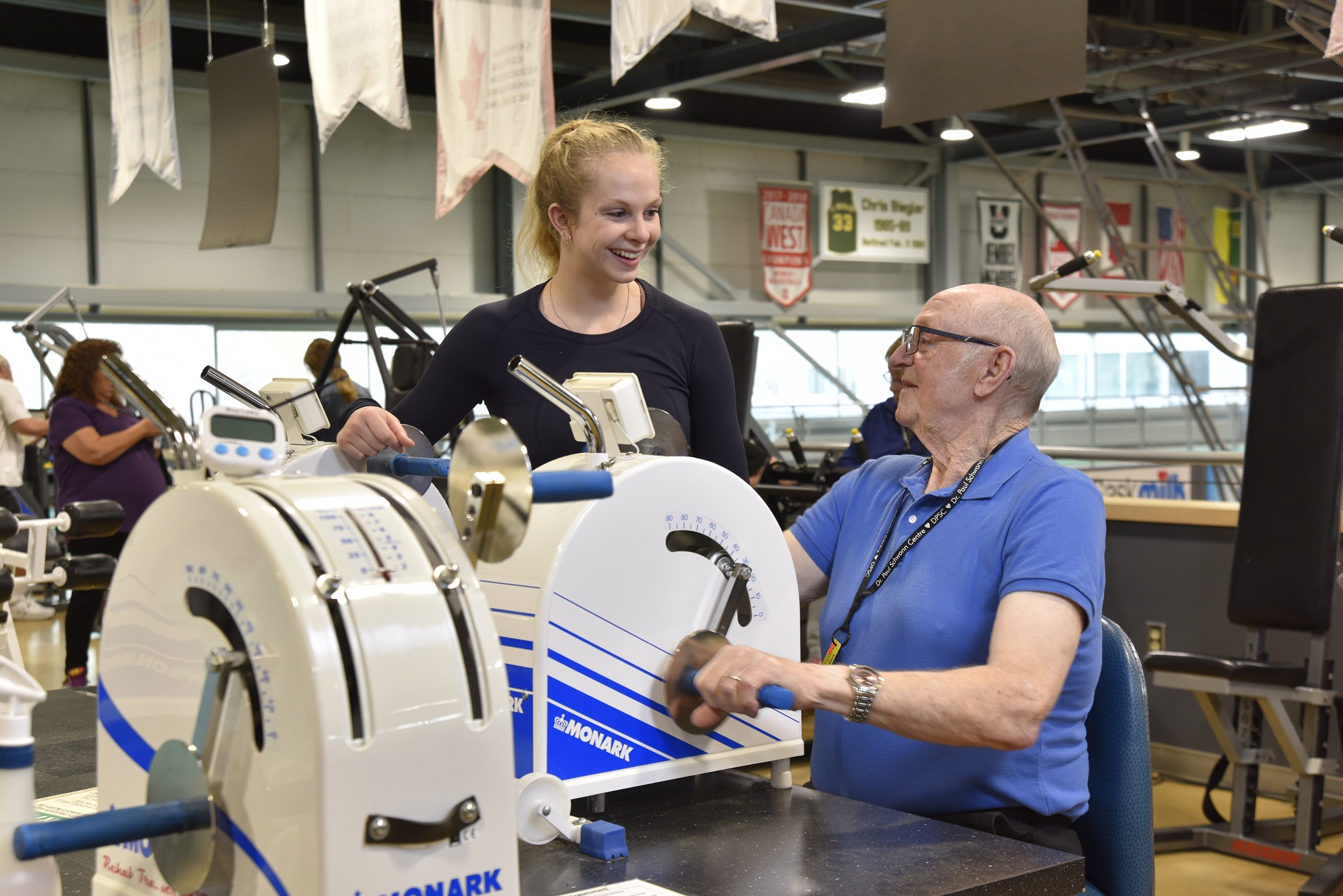
Danielle has her sights set on medical school, but also sees a future for herself as a physiotherapist, understanding first-hand the struggles that elite athletes face in pursuit of athletic perfection. She is just as passionate about women’s rights, and the fact that many women feel uncomfortable speaking up about what they need from their physicians and OBGYNs. “I want to educate women and normalize health care for women,” she says passionately. “I want to use whatever platform I have to be a champion of women.”
Danielle admits that she is a relatively private person uncomfortable with the spotlight. “But if I can inspire other young women to pursue their education and reach for their own dreams, then I want to do it.”
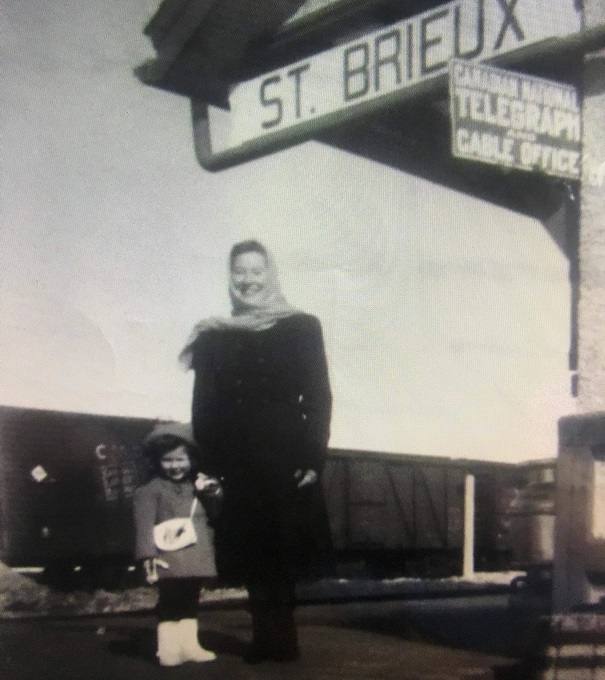
In many ways, Danielle is much like her beloved grandmother, known simply as Oma, who was born and raised in Holland. Oma’s father was a banker, and when Jewish families were being sent out of cities to concentration camps and pending death, the family hid a young Jewish girl, the daughter of a fellow banker. It was during this time that Danielle’s grandfather served as a Canadian soldier during the Second World War. Family lore has it that he was driving his tank through the streets of Holland during the liberation when his tank splashed an attractive young woman on the sidewalk. When he stopped his armoured vehicle to get out and apologize, Oma instinctively slapped him on the cheek.
“She was feisty and opinionated and stood up for herself,” Danielle laughs, exuding the same feisty spirit. “They ended up falling in love and getting married. My Oma was pregnant with my aunt when she took a boat over to Canada, landing in Halifax, and traveling by train to St. Brieux, where my grandfather was from to begin raising her family.”
Generations later, as Danielle’s mom Lisa explains, the four Major daughters grew up in a remodelled 1913 one-room school house on the farm, with a ladder leading to the sleeping quarters and one tiny bathroom upstairs. “It was pretty tight quarters as you can imagine,” laughs Lisa, a city girl herself who became a nurse and fell in love with a quiet farm boy with big dreams of his own. “We had an old wood stove for heat and all of the girls learned how to split wood and do their part to keep the house warm and the farm operational.”
Danielle’s dad Charlie, the family patriarch, knew from a young age that he wanted to set off and establish a farm of his own, since his parent’s half-section wasn’t large enough for the next generation to subdivide and earn a living.
“My folks weren’t wealthy and I had to secure financing for the first quarter of land,” he begins. “When the high interest rates of the ‘80s hit, I had to work the oil patch to bring in enough money to keep things afloat. In the mid ‘90s, I bought eight head of cattle and grew it to what it is today. But it wasn’t easy. When BSE (bovine spongiform encephalitis – a serious cattle infection) hit in 2003, I went for a walk and knew we were in trouble. An infected animal was found in Alberta, but all of a sudden the borders were closed and we couldn’t sell our cows to anyone, yet we still had to feed them and keep up with the operation. It was a really challenging time. We still had to do all the work and we couldn’t get paid.”
The family struggled financially and emotionally. Lisa worked full time as a nurse manager to support the family while Charlie tended to the farm, teaching his young daughters how to tie their shoes, feed the animals, and excel in school. In spite of Charlie’s and Lisa’s best efforts to stay positive, that event left an indelible imprint on all of the girls. Daughter Ashley says BSE taught them that nothing in life can be taken for granted.
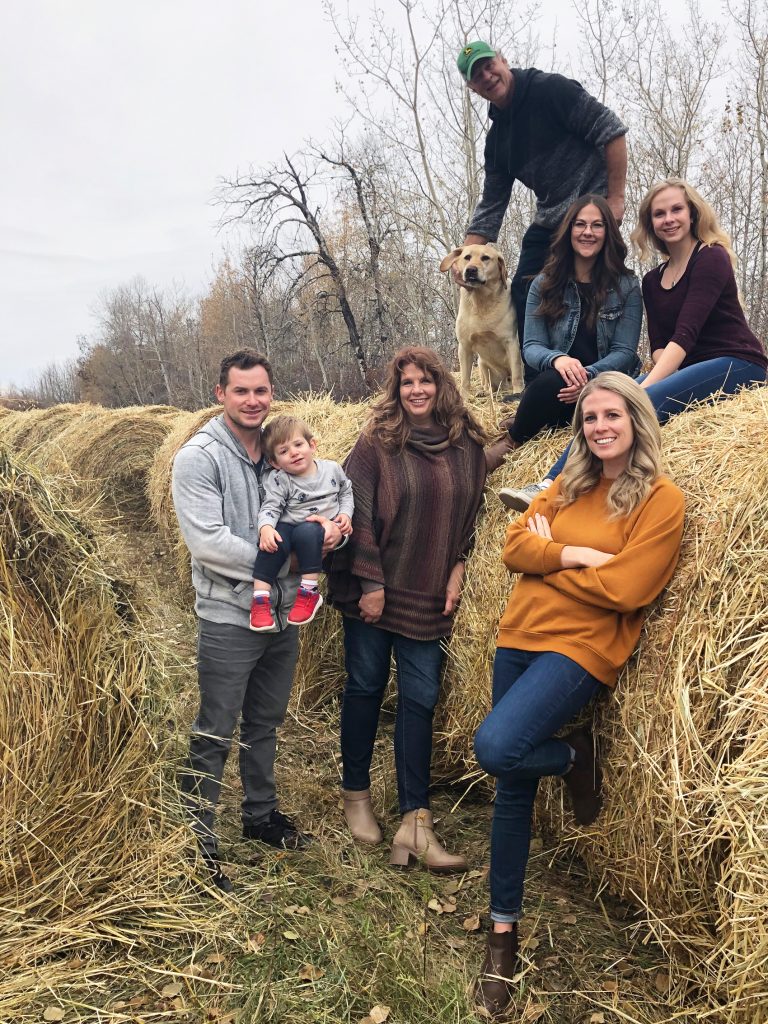
“It was a very stressful time to think that we might be one of those families that could lose their farm,” Ashley recalls. “But it taught us to be prepared and to make our own way in the world. It imparted in us a maturity and a resiliency that I don’t think we would have received if we’d grown up in the city. The farm is in our soul. It’s a really important part of our personalities.”
With little money to go around, and not many luxuries, the girls would often entertain themselves with fashion shows and plays. Danielle, as the baby, would be the “little dolly” but the feisty little firecracker didn’t want that nominal role. “She was wise beyond her years,” says Ashley. “She grew up to be the most academic out of all of us, the best athlete, the best at everything. She got her incredible language skills from our mom, and our dad’s ability with math. She just inherited the best of each parent’s gifts.”
Danielle was affectionately known as Curly Sue growing up because of her mass of blonde curls, but her sisters say you weren’t to be fooled by all of that cuteness because Danielle meant business, with an independent streak all her own.
“She was the funniest kid – so headstrong – with a vocabulary and intellect well beyond her years,” Larissa recalls. “I remember a friend of mine gave her a veterinary textbook as a gift when she was about seven or eight, and she loved that thing and read it cover to cover. It was just insane! People would talk to her and then say, ‘Is this kid for real?’”
Sister Katelyn says Danielle stood out from her peers right from the beginning.
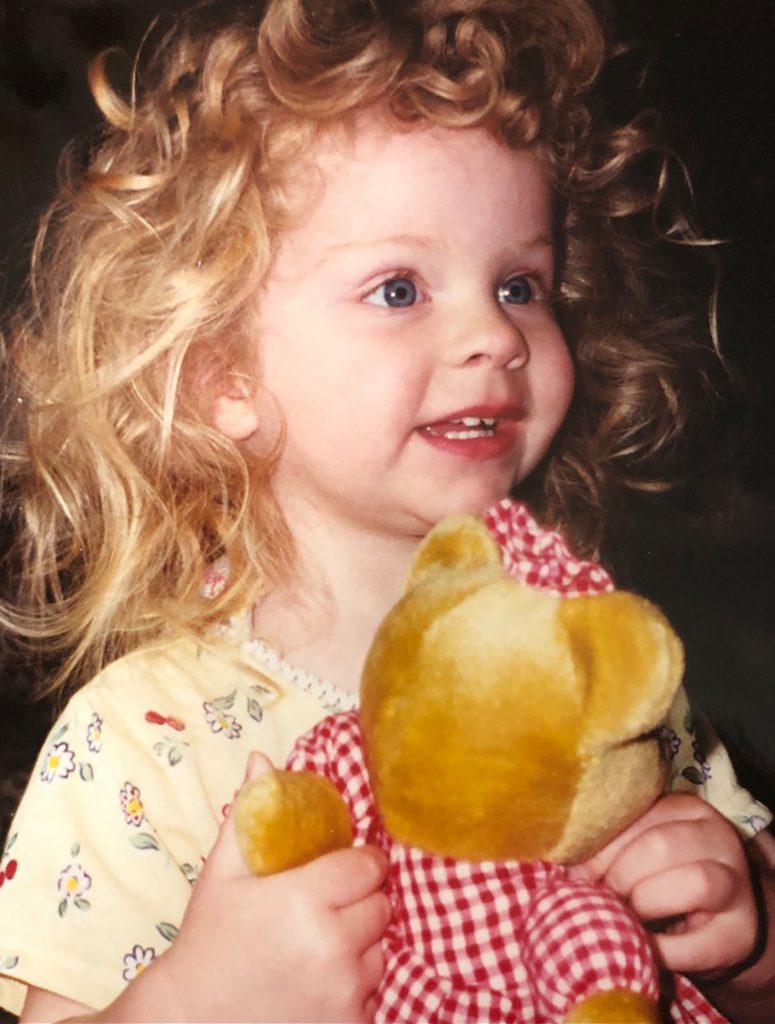
“I never had to remind her to do her homework as a youngster. She was so self-motivated that when a Saskatchewan snowstorm would blow in causing the school bus to shut down, Danielle would beg her dad to get the truck out and blaze a trail to get to school.”
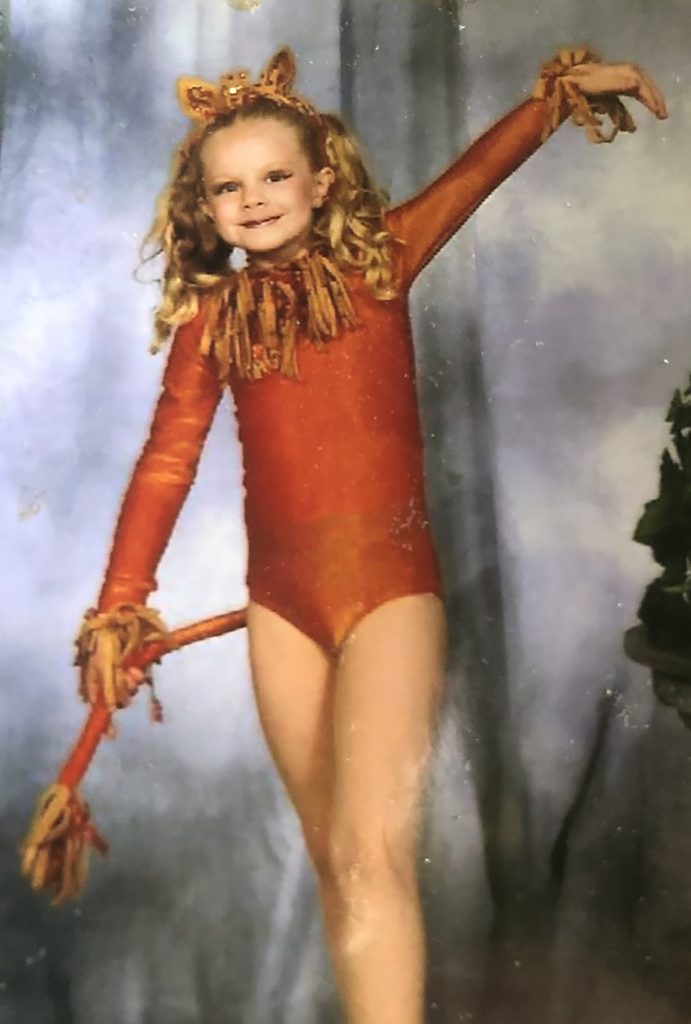
“I remember she had just started dance class, and the teacher asked the little kids if they had a good weekend, and everyone was chiming in with uh-huhs and yeahs, typical of five-year-olds, and here’s little Danielle pronouncing with perfect diction, “Yes, it was magnificent!’ She had this mature idea of the world from a very young age, probably because our mom is such a gifted writer and speaker, and our parents never talked to us like we were babies. We had chores and responsibilities and knew very early on that we’d have to make our way in the world.”
Lisa says all of the girls worked hard and were exceptional students, but Danielle was the most serious of them all. “I never had to remind her to do her homework as a youngster. She was so self-motivated that when a Saskatchewan snowstorm would blow in causing the school bus to shut down, Danielle would beg her dad to get the truck out and blaze a trail to get to school. She never wanted to miss class – ever – even though the girls easily could have taken a snow day,” Mom recalls with a smile.
“I just knew, even at a very young age, that if I worked extremely hard, I could obtain scholarships and support myself through school. I’ve been incredibly fortunate and have received $45,000 in scholarships. It’s allowed me to have a wholly enriched academic experience,” Danielle says proudly.
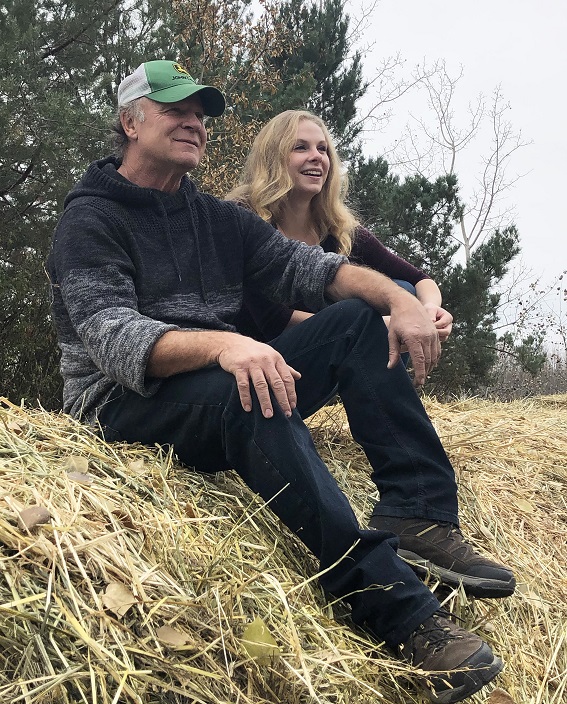
While Danielle is never without her textbooks, her focus at this moment, is with the calves and the job at hand. She takes a much-deserved break and gathers for some family photos on nearby bales of hay. She sits with her dad overlooking the animals and a job well done. Their interplay is quiet, each intuitively understanding the other.
“I always told my girls, ‘Don’t count on a man to make your way in life. Things can go wrong. Be your own boss and find your own way,’” says Charlie. Each of his daughters have heeded those words, all accomplished university graduates with Danielle set to graduate next Spring. They have all built independent futures away from the farm – at least for now. Dad reminds them that this land that they love so dearly will always be there for them to enjoy.
“It’s peaceful here and I can relax and enjoy myself without the intrusion of cars and people. It’s a place of solitude and privacy for me,” Danielle says contentedly. “I definitely see an acreage in my future.”
As for her future career, it’s anybody’s guess. Doctor? Physiotherapist? Animal whisperer? Danielle knows her eventual career will soon take flight, just like the last remnants of Fall leaves that begin to swirl and scatter with the latest gust of wind.
To help make a difference in the lives of other students like Danielle, please consider a gift to the Fall 2019 Appeal. For more information, please click here.

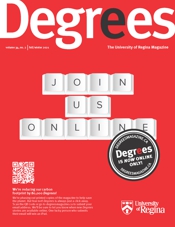

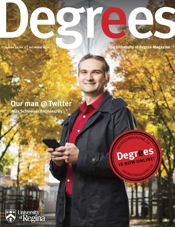


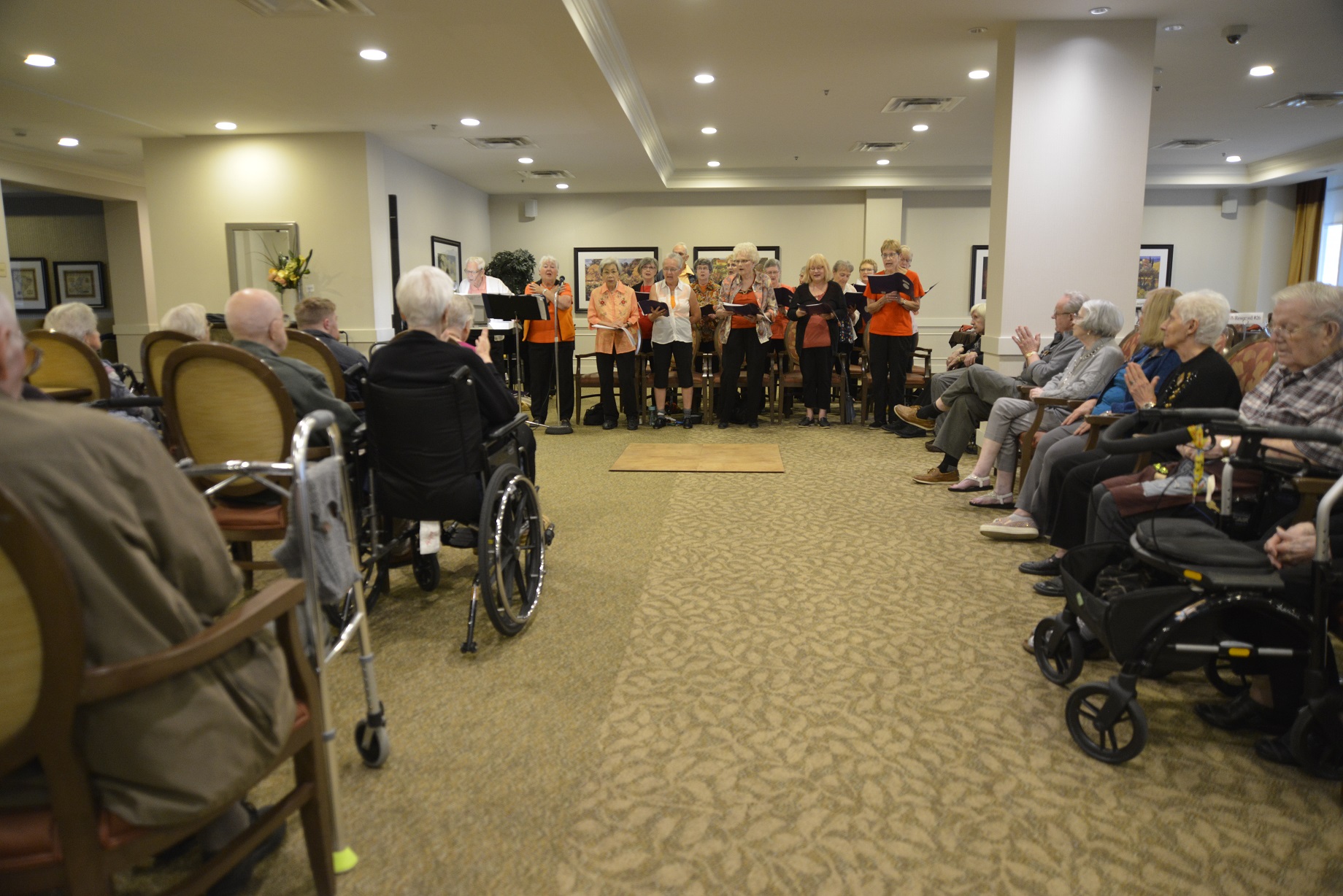 Residents of College Park II, a retirement residence, are entertained by a local choir. A landmark 2013 study by the Montreal Neurological Institute showed clearly the benefits music has on the brain. Photo by Don Hall
In his article, “How music affects the brain,” Jacob Berkowitz highlights the important finding that there is no music centre in the brain; that music is about much more than sound, also tapping into areas of the brain that represent movement, emotion, language, and vision. Using a CT scanner, two researchers at the Montreal Neurological Institute, in a landmark study published in the journal Science in 2013, reported that when favourite pieces of music were played for participants, their brains released the pleasure-related neurotransmitter dopamine several seconds before the emotional crescendo of the music, establishing clear links among music, emotion, and neurotransmitters.
Residents of College Park II, a retirement residence, are entertained by a local choir. A landmark 2013 study by the Montreal Neurological Institute showed clearly the benefits music has on the brain. Photo by Don Hall
In his article, “How music affects the brain,” Jacob Berkowitz highlights the important finding that there is no music centre in the brain; that music is about much more than sound, also tapping into areas of the brain that represent movement, emotion, language, and vision. Using a CT scanner, two researchers at the Montreal Neurological Institute, in a landmark study published in the journal Science in 2013, reported that when favourite pieces of music were played for participants, their brains released the pleasure-related neurotransmitter dopamine several seconds before the emotional crescendo of the music, establishing clear links among music, emotion, and neurotransmitters.
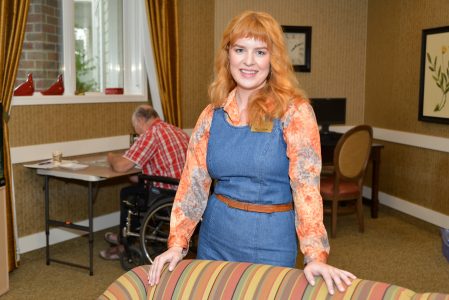 Alynn Skalicky BSRS’16, a certified therapeutic recreation specialist at College Park II, says the music program has instilled a larger sense of community because of the coming and goings of the volunteer music instructors. Photo by Don Hall
Much of the current research being conducted by neuroscientists involves using recorded music. Alynn Skalicky BSRS’16 is a certified therapeutic recreation specialist at College Park II in Regina. She points out that the seniors residence has an accredited music therapist who works with residents one-on-one, or in small group sessions, using recorded music.
The individualized program that Kim Shalley BSRS’19, a recent graduate in the Therapeutic Recreation program at the U of R, proposed and developed for residents of College Park II was different: a one-on-one music recreation program geared to residents’ specific musical interests, encouraging them to play instruments as partners with volunteers from the community. The idea was a natural outgrowth of the large role music played in Shalley’s own family life. She cherishes her memories of being with her grandparents and watching them dance at weddings and family celebrations. “I think music really does bring people together, and I saw that there were some residents who weren’t involved in many programs,” she explains.
Shalley completed a student placement at College Park II as part of her 560 hours of fieldwork, a requirement of all of the Kinesiology and Health Studies degree programs, including Therapeutic Recreation. Her placement enabled her to apply what she had learned in the classroom about assessing, planning, implementing, and evaluating programs. She played a leading role in developing and implementing a special project; in her case, the community music recreation program.
Putting those classroom skills into practice is one of the objectives of the fieldwork, explains Brandy West-McMaster, an instructor and the experiential learning coordinator in the Faculty of Kinesiology and Health Studies. She helps guide the students through their fieldwork in their third and fourth years. As far as she is aware, the 560-hour requirement is greater than other similar programs in Canada, ensuring that U of R graduates are well prepared to begin their careers. It often also helps them determine what direction they would like to take within their chosen profession.
Alynn Skalicky BSRS’16, a certified therapeutic recreation specialist at College Park II, says the music program has instilled a larger sense of community because of the coming and goings of the volunteer music instructors. Photo by Don Hall
Much of the current research being conducted by neuroscientists involves using recorded music. Alynn Skalicky BSRS’16 is a certified therapeutic recreation specialist at College Park II in Regina. She points out that the seniors residence has an accredited music therapist who works with residents one-on-one, or in small group sessions, using recorded music.
The individualized program that Kim Shalley BSRS’19, a recent graduate in the Therapeutic Recreation program at the U of R, proposed and developed for residents of College Park II was different: a one-on-one music recreation program geared to residents’ specific musical interests, encouraging them to play instruments as partners with volunteers from the community. The idea was a natural outgrowth of the large role music played in Shalley’s own family life. She cherishes her memories of being with her grandparents and watching them dance at weddings and family celebrations. “I think music really does bring people together, and I saw that there were some residents who weren’t involved in many programs,” she explains.
Shalley completed a student placement at College Park II as part of her 560 hours of fieldwork, a requirement of all of the Kinesiology and Health Studies degree programs, including Therapeutic Recreation. Her placement enabled her to apply what she had learned in the classroom about assessing, planning, implementing, and evaluating programs. She played a leading role in developing and implementing a special project; in her case, the community music recreation program.
Putting those classroom skills into practice is one of the objectives of the fieldwork, explains Brandy West-McMaster, an instructor and the experiential learning coordinator in the Faculty of Kinesiology and Health Studies. She helps guide the students through their fieldwork in their third and fourth years. As far as she is aware, the 560-hour requirement is greater than other similar programs in Canada, ensuring that U of R graduates are well prepared to begin their careers. It often also helps them determine what direction they would like to take within their chosen profession.
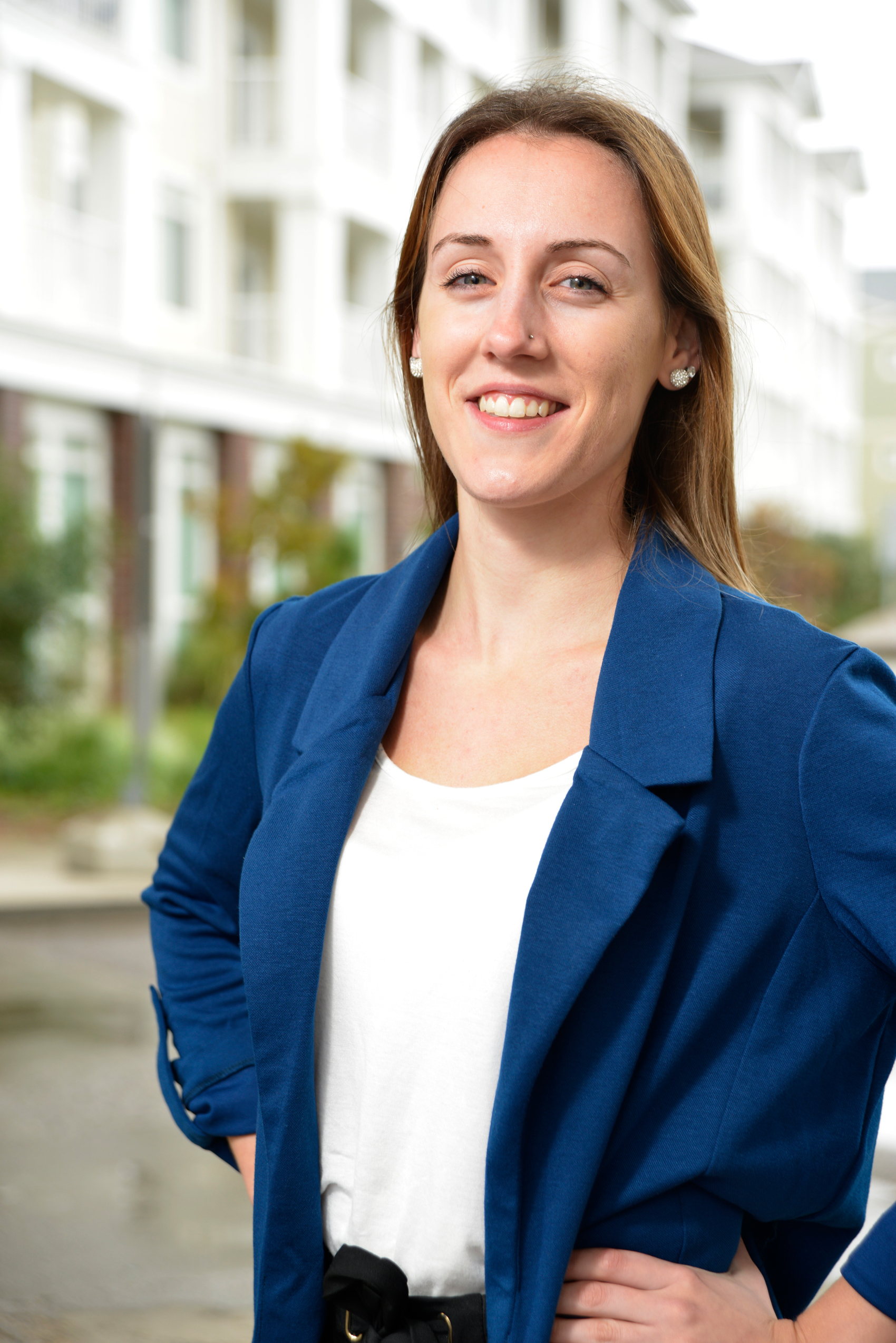 Kim Shalley BSRS’19, a recent graduate in the Therapeutic Recreation program at the U of R, proposed and developed the music program for residents of College Park II. Photo by Don Hall
“It takes time for students to develop relationships where they take their placements and to understand the processes in those places,” adds West-McMaster. “From the feedback we receive from the students and the consenting supervisors where they do their placements, the extra time helps.”
According to West-McMaster, Shalley did a good job of using that extra time to apply what she learned in the TR program. “She embodied that special project and made it her own.”
Skalicky was Shalley’s supervisor during her placement. When she began working at College Park II, she found that some residents were isolating themselves, as Shalley also observed. “Finding some recreation that was meaningful for them meant digging into residents’ histories and needs to find something that would entice them to come out and participate in a program,” Skalicky says. Student placements are a godsend for her and other staff members, she notes, since they often don’t have “the time or the hands” to plan and facilitate all of the programs they might like. She also values them because they help her maintain her own personal and professional connections with the U of R.
Kim Shalley BSRS’19, a recent graduate in the Therapeutic Recreation program at the U of R, proposed and developed the music program for residents of College Park II. Photo by Don Hall
“It takes time for students to develop relationships where they take their placements and to understand the processes in those places,” adds West-McMaster. “From the feedback we receive from the students and the consenting supervisors where they do their placements, the extra time helps.”
According to West-McMaster, Shalley did a good job of using that extra time to apply what she learned in the TR program. “She embodied that special project and made it her own.”
Skalicky was Shalley’s supervisor during her placement. When she began working at College Park II, she found that some residents were isolating themselves, as Shalley also observed. “Finding some recreation that was meaningful for them meant digging into residents’ histories and needs to find something that would entice them to come out and participate in a program,” Skalicky says. Student placements are a godsend for her and other staff members, she notes, since they often don’t have “the time or the hands” to plan and facilitate all of the programs they might like. She also values them because they help her maintain her own personal and professional connections with the U of R.
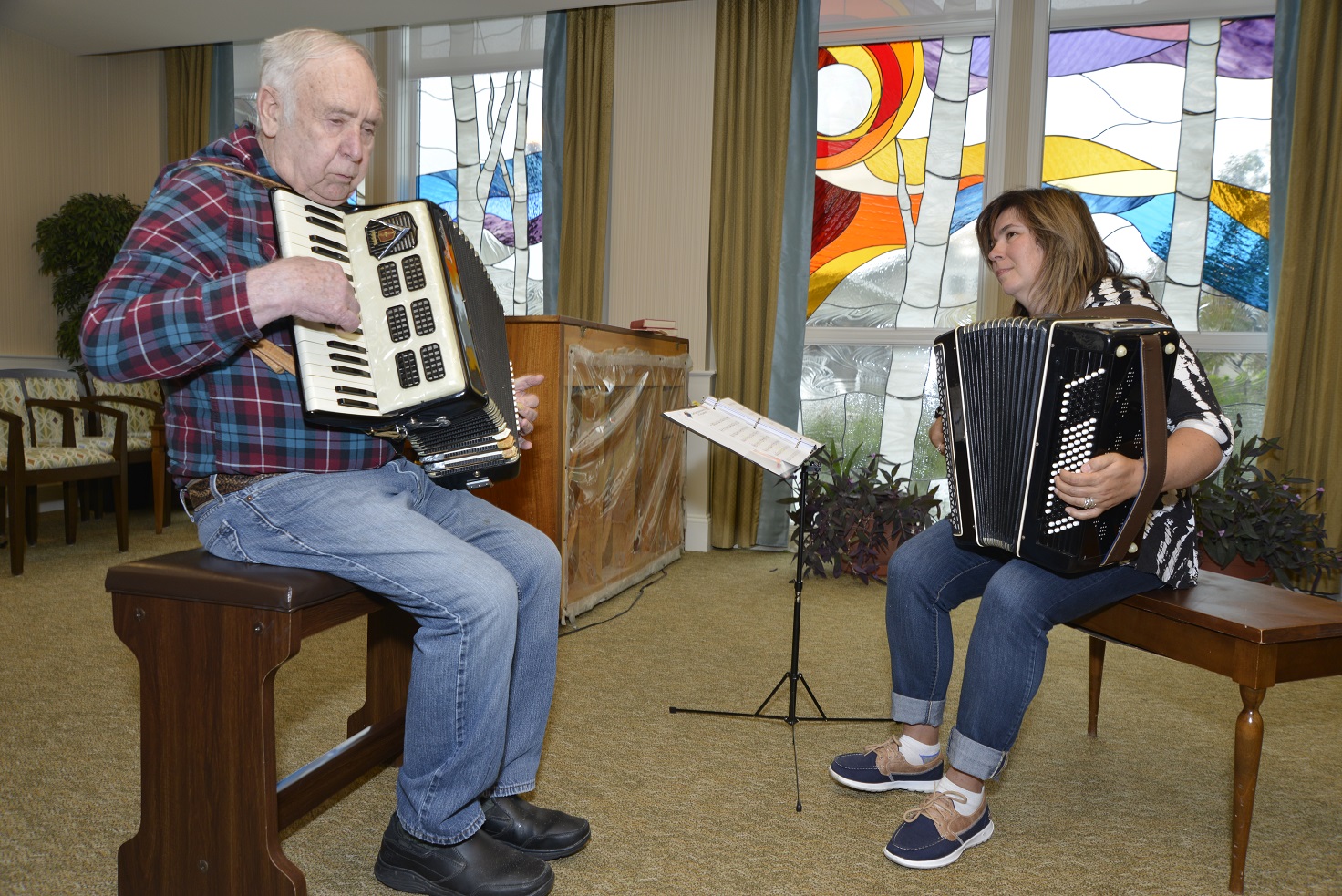 Natalia Osypenko has become Dale Hulston’s regular music partner. She says playing with Hulston reminds her of her grandparent’s love of music. Photo by Don Hall
Natalia Osypenko saw a post in a musicians’ group on Facebook and signed up right away. She had earned a degree in Music in Ukraine before immigrating to Regina, and like Hulston, she learned to play the accordion when she was young. During their first meeting, she recalls, he played The Blue Skirt Waltz for her. “I went home and found the music and now I play it with him. Playing with Dale reminds me of my grandparents’ love of music; we are having fun, but playing and listening to music also empowers these people.” She and Hulston have since become regular musical partners.
The program began slowly, Shalley says, but gained momentum as more volunteers began to visit residents who wanted to take up their instrument again. It was something of a surprise and a bonus, Skalicky adds, when some residents who had never played an instrument approached her, saying they wanted to learn.
“We set up the pilot project in a public space because we knew that would pique the curiosity of other residents, seeing the volunteers coming and going with their instruments and music, and hearing them working one-on-one with residents,” Skalicky explains. “The program sort of grew through word-of-mouth and from seeing others participating in it.”
Natalia Osypenko has become Dale Hulston’s regular music partner. She says playing with Hulston reminds her of her grandparent’s love of music. Photo by Don Hall
Natalia Osypenko saw a post in a musicians’ group on Facebook and signed up right away. She had earned a degree in Music in Ukraine before immigrating to Regina, and like Hulston, she learned to play the accordion when she was young. During their first meeting, she recalls, he played The Blue Skirt Waltz for her. “I went home and found the music and now I play it with him. Playing with Dale reminds me of my grandparents’ love of music; we are having fun, but playing and listening to music also empowers these people.” She and Hulston have since become regular musical partners.
The program began slowly, Shalley says, but gained momentum as more volunteers began to visit residents who wanted to take up their instrument again. It was something of a surprise and a bonus, Skalicky adds, when some residents who had never played an instrument approached her, saying they wanted to learn.
“We set up the pilot project in a public space because we knew that would pique the curiosity of other residents, seeing the volunteers coming and going with their instruments and music, and hearing them working one-on-one with residents,” Skalicky explains. “The program sort of grew through word-of-mouth and from seeing others participating in it.”
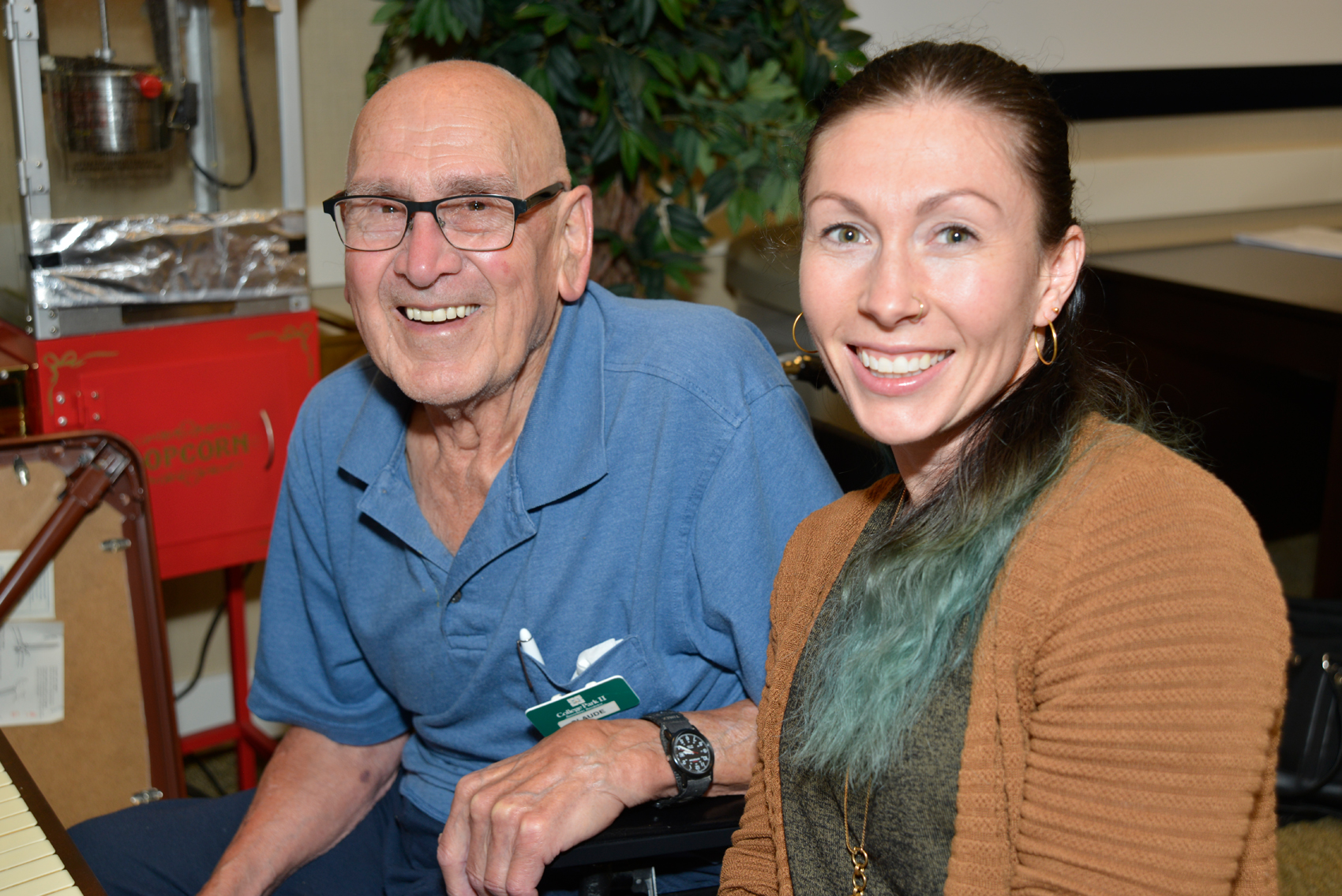 Mandy Ebel, a singer-songwriter, vocal coach, and music producer is one of the program volunteers. She regularly visits College Park II to help Claude Crozon learn and re-learn songs after a stroke and two mild heart attacks left him without memories. Photo by Don Hall
While Hulston entertains a circle of listeners in one room, down the hall in another room, Claude Crozon and Mandy Ebel are seated at a piano singing Amazing Grace. Crozon was one of the first residents to join the program. His family grew up “really poor” on a farm near Gravelbourg, where singing was one of their forms of entertainment. He sang in church choirs throughout his life, while teaching in various communities around Saskatchewan. However, a stroke and two mild heart attacks left him without any memory. Now he is working with Ebel on learning, or relearning, several songs.
Mandy Ebel, a singer-songwriter, vocal coach, and music producer is one of the program volunteers. She regularly visits College Park II to help Claude Crozon learn and re-learn songs after a stroke and two mild heart attacks left him without memories. Photo by Don Hall
While Hulston entertains a circle of listeners in one room, down the hall in another room, Claude Crozon and Mandy Ebel are seated at a piano singing Amazing Grace. Crozon was one of the first residents to join the program. His family grew up “really poor” on a farm near Gravelbourg, where singing was one of their forms of entertainment. He sang in church choirs throughout his life, while teaching in various communities around Saskatchewan. However, a stroke and two mild heart attacks left him without any memory. Now he is working with Ebel on learning, or relearning, several songs.
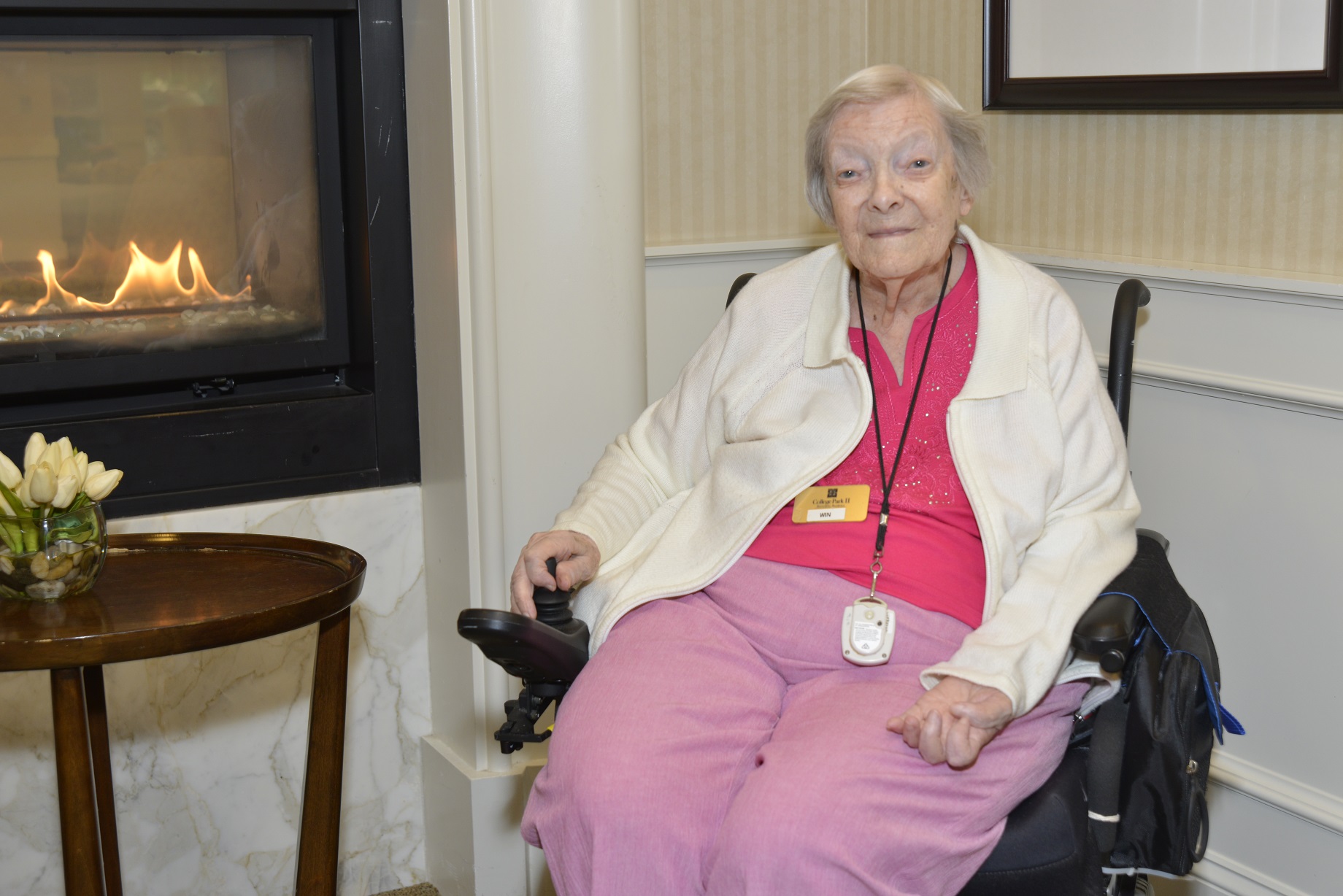 Despite the fact that College Park II resident Winnifred Miller lost the use of one hand because of a stroke, she is taking drumming lessons from Curtis Hinks, a member of the Saskatchewan Roughriders Drumline and professional drumming teacher. Photo by Don Hall
In their first lesson, Hinks, who is also a member of the Saskatchewan Roughriders Drumline, showed Miller two ways to hold the drumstick and how to make a single drum note. During their four lessons together, they have explored rhythms, sometimes playing to the beat of the music and then leaving out a beat.
“The drum is the timekeeper in the music,” Miller states as a smile lights up her face. “The drum beat is like the bass note on a piano; it just reaches out and grabs me.” She looks forward to her lessons, she adds, describing working with youth in this way as a role reversal from her earlier life as a teacher.
Despite the fact that College Park II resident Winnifred Miller lost the use of one hand because of a stroke, she is taking drumming lessons from Curtis Hinks, a member of the Saskatchewan Roughriders Drumline and professional drumming teacher. Photo by Don Hall
In their first lesson, Hinks, who is also a member of the Saskatchewan Roughriders Drumline, showed Miller two ways to hold the drumstick and how to make a single drum note. During their four lessons together, they have explored rhythms, sometimes playing to the beat of the music and then leaving out a beat.
“The drum is the timekeeper in the music,” Miller states as a smile lights up her face. “The drum beat is like the bass note on a piano; it just reaches out and grabs me.” She looks forward to her lessons, she adds, describing working with youth in this way as a role reversal from her earlier life as a teacher.
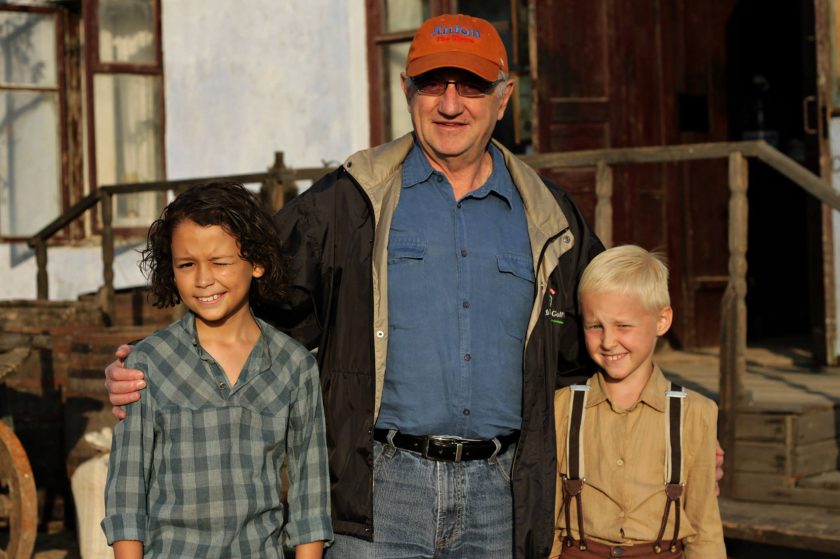 Dale Eisler with the young stars of Anton near Odessa, Ukraine where the film was shot. Nikita Shlanchak (left) who plays Anton, and Mykyta Dziad who plays Jacob. Right: Eisler on the set of Anton, the film is based on Eisler’s book Anton: A Young Boy, His Friend and the Russian Revolution published in 2010.
Eisler turned to other sources, researching various books and documents on the Bolshevik Revolution and the Ukraine. He was living in the U.S. at the time, and joined the Germans From Russia Heritage Society, which had members all over the country doing genealogical research of that period. He also attended some of the Society’s conventions.
Drawing on these sources, Eisler wrote Anton: A Young Boy, His Friend and the Russian Revolution, which was published in 2010. The story focuses on the childhood experiences of Anton and Jacob, who create an imaginary world to shield themselves from the violence and hatred taking place around them. Although Anton is Catholic and Jacob is Jewish, the two forge a lifelong bond through their shared imaginations and exploration of spiritual questions.
Dale Eisler with the young stars of Anton near Odessa, Ukraine where the film was shot. Nikita Shlanchak (left) who plays Anton, and Mykyta Dziad who plays Jacob. Right: Eisler on the set of Anton, the film is based on Eisler’s book Anton: A Young Boy, His Friend and the Russian Revolution published in 2010.
Eisler turned to other sources, researching various books and documents on the Bolshevik Revolution and the Ukraine. He was living in the U.S. at the time, and joined the Germans From Russia Heritage Society, which had members all over the country doing genealogical research of that period. He also attended some of the Society’s conventions.
Drawing on these sources, Eisler wrote Anton: A Young Boy, His Friend and the Russian Revolution, which was published in 2010. The story focuses on the childhood experiences of Anton and Jacob, who create an imaginary world to shield themselves from the violence and hatred taking place around them. Although Anton is Catholic and Jacob is Jewish, the two forge a lifelong bond through their shared imaginations and exploration of spiritual questions.
 Depending on the film’s reception during its U.S. run, Anton could have screenings in Canada — including Saskatchewan — in 2020.
“One of the things I wanted to do,” Eisler explains, “was to explore the universal experience of childhood friendships, because we all go through that. You go through life and have all sorts of acquaintances — people you know — but others are friends. What does that mean?”
Eisler’s answer was to show that the friendship between Anton and Jacob was greater than the forces of division swirling around them. Another theme he wanted to explore was the yearning for a new life, which he sees as being at the core of the Canadian and North American immigrant experience. This was the case for Eisler’s grandmother, who settled with some of her children in Saskatchewan in 1925. The book and the movie mirror this family history. Anton and Jacob are separated, but their friendship endures, influencing their lives until they reconnect decades later as Anton is dying.
Depending on the film’s reception during its U.S. run, Anton could have screenings in Canada — including Saskatchewan — in 2020.
“One of the things I wanted to do,” Eisler explains, “was to explore the universal experience of childhood friendships, because we all go through that. You go through life and have all sorts of acquaintances — people you know — but others are friends. What does that mean?”
Eisler’s answer was to show that the friendship between Anton and Jacob was greater than the forces of division swirling around them. Another theme he wanted to explore was the yearning for a new life, which he sees as being at the core of the Canadian and North American immigrant experience. This was the case for Eisler’s grandmother, who settled with some of her children in Saskatchewan in 1925. The book and the movie mirror this family history. Anton and Jacob are separated, but their friendship endures, influencing their lives until they reconnect decades later as Anton is dying.
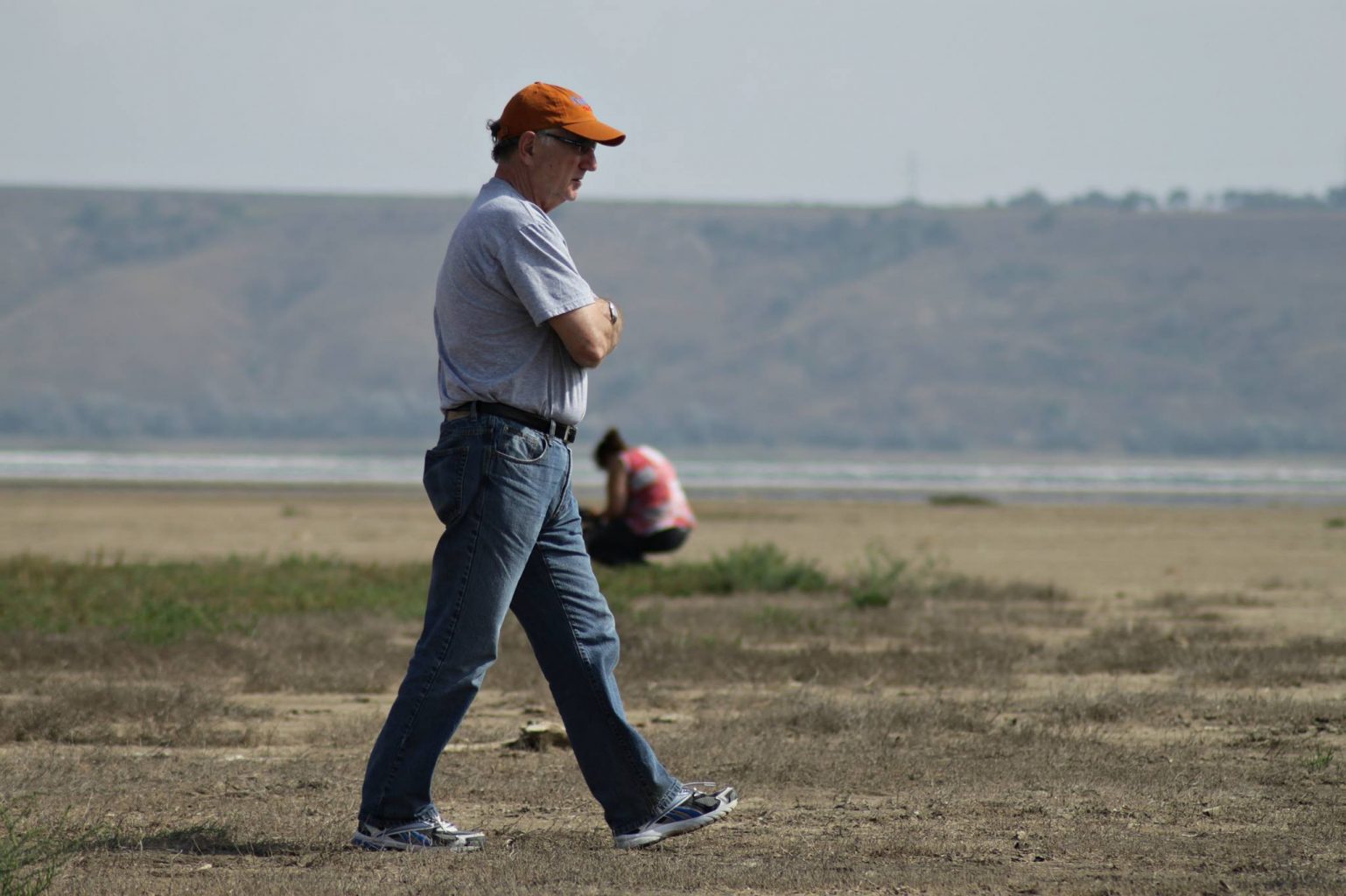 Eisler takes a walk while on the set of Anton near Odessa, Ukraine.
Ironically, it was the desire for a new life that brought Eisler’s grandparents to Ukraine. During her reign as Empress of Russia, Catherine the Great had expanded the country’s borders to the Black Sea. She welcomed immigrants — particularly from Germany — to settle on the newly acquired rich agricultural land near Odessa. Her promises of land ownership, no military service, and low taxes, along with assurances that they could keep their own language, religion and culture, attracted many farmers and tradespeople from Germany. This included villages populated by German immigrants that began to flourish in Ukraine in the late 18th Century.
The success of these German colonies bred envy and resentment among Russia’s landless serfs, who became a powerful force as the Tsarist government collapsed. Coupled with rampant antisemitism and unease within the Orthodox Church over the growing Catholic presence in the country, the stage was set for an outburst of economic, ethnic and sectarian score-settling after the Russian Revolution in 1917.
Following its release, Eisler’s book received some good reviews and was “modestly well received.” A number of people told him the book would make a great movie. “I thought, yeah, well, that is a nice compliment,” Eisler recalls. “I appreciated it, but didn’t think more of it than that. I agree. It is a good story; a unique story, and a story that’s never really been told.”
When he’s not novel writing or screenwriting, Eisler serves as the University’s senior adviser (Government Relations) and is a senior policy fellow at the Johnson Shoyama Graduate School of Public Policy.
Eisler takes a walk while on the set of Anton near Odessa, Ukraine.
Ironically, it was the desire for a new life that brought Eisler’s grandparents to Ukraine. During her reign as Empress of Russia, Catherine the Great had expanded the country’s borders to the Black Sea. She welcomed immigrants — particularly from Germany — to settle on the newly acquired rich agricultural land near Odessa. Her promises of land ownership, no military service, and low taxes, along with assurances that they could keep their own language, religion and culture, attracted many farmers and tradespeople from Germany. This included villages populated by German immigrants that began to flourish in Ukraine in the late 18th Century.
The success of these German colonies bred envy and resentment among Russia’s landless serfs, who became a powerful force as the Tsarist government collapsed. Coupled with rampant antisemitism and unease within the Orthodox Church over the growing Catholic presence in the country, the stage was set for an outburst of economic, ethnic and sectarian score-settling after the Russian Revolution in 1917.
Following its release, Eisler’s book received some good reviews and was “modestly well received.” A number of people told him the book would make a great movie. “I thought, yeah, well, that is a nice compliment,” Eisler recalls. “I appreciated it, but didn’t think more of it than that. I agree. It is a good story; a unique story, and a story that’s never really been told.”
When he’s not novel writing or screenwriting, Eisler serves as the University’s senior adviser (Government Relations) and is a senior policy fellow at the Johnson Shoyama Graduate School of Public Policy.
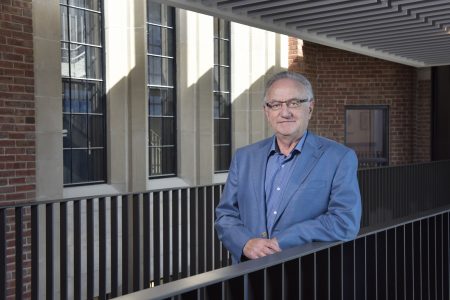 Eisler later decided he would write a script. He read a number of scripts and screenplays, and, writing on and off over a two-month period, completed his own. It was a different kind of writing process, he explains. While in a novel the story is primarily carried by the narration, in a screenplay the story moves forward through dialogue and the interaction of the characters.
The next step was to find a producer. Eisler, who was Canada’s Consul General in Denver, reached out to his counterpart in Los Angeles to help find a producer. He connected with Mirza Davitaia, who had worked in film and television production, and also served as a government minister in his home country, the Republic of Georgia, before establishing a production company in Los Angeles. Eisler sent him the script and the two met in Los Angeles. Davitaia very much liked the storyline and the concept.
“I saw it as a clash of two worlds,” says Davitaia. “The clash between the world of simple childhood and the brutal world of adults. The cave where Anton and Jacob meet is their small, childish, wonderful world, while the larger world outside is going through a transformation.”
Eisler later decided he would write a script. He read a number of scripts and screenplays, and, writing on and off over a two-month period, completed his own. It was a different kind of writing process, he explains. While in a novel the story is primarily carried by the narration, in a screenplay the story moves forward through dialogue and the interaction of the characters.
The next step was to find a producer. Eisler, who was Canada’s Consul General in Denver, reached out to his counterpart in Los Angeles to help find a producer. He connected with Mirza Davitaia, who had worked in film and television production, and also served as a government minister in his home country, the Republic of Georgia, before establishing a production company in Los Angeles. Eisler sent him the script and the two met in Los Angeles. Davitaia very much liked the storyline and the concept.
“I saw it as a clash of two worlds,” says Davitaia. “The clash between the world of simple childhood and the brutal world of adults. The cave where Anton and Jacob meet is their small, childish, wonderful world, while the larger world outside is going through a transformation.”
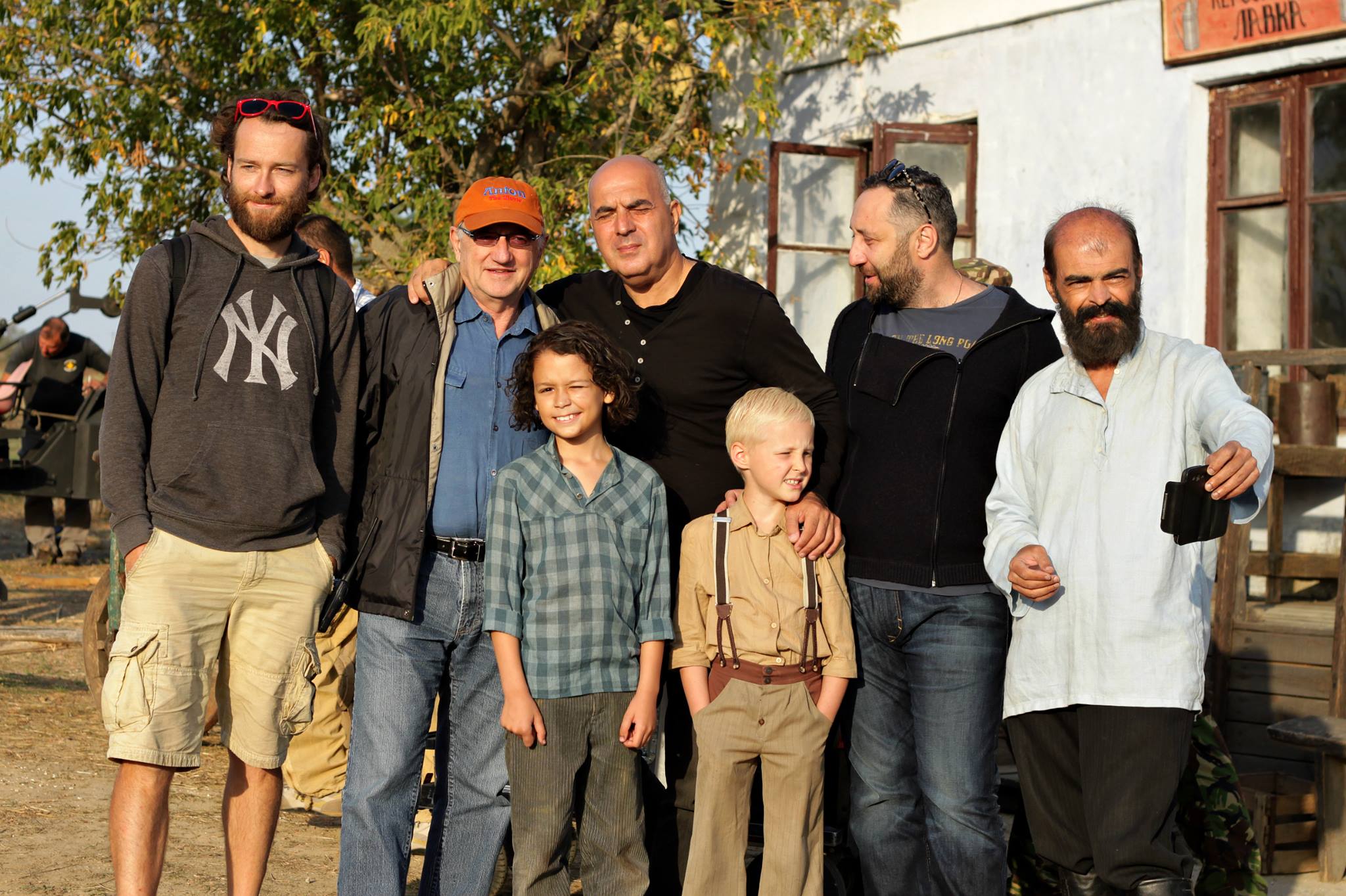 On the set in a small village near Odessa, Ukraine. From left to right: Director of Photography Mikhail Petrenko; Dale Eisler; Director Zaza Urushadze; co-producer Mirza Davitaia; actor Vladimer Levitzki. Front row left to right Nikita Shlanchak who plays Anton and Mykyta Dziad who plays Jacob.
As the producer, Davitaia explains, it was his job to assemble everything around the idea. In the world of movie production, the most important step is to attract a director who is willing to take on the project. As in many other businesses, networking plays a major role in this process. Davitaia reached out to Zaza Urushadze, who was also from his hometown of Tbilisi, Georgia. Urushadze had recently had a film nominated for an Academy Award and a Golden Globe Award as best foreign-language film. They had talked in the past about several projects, Davitaia says, and Urushadze agreed this would be a good one to work on together.
On the set in a small village near Odessa, Ukraine. From left to right: Director of Photography Mikhail Petrenko; Dale Eisler; Director Zaza Urushadze; co-producer Mirza Davitaia; actor Vladimer Levitzki. Front row left to right Nikita Shlanchak who plays Anton and Mykyta Dziad who plays Jacob.
As the producer, Davitaia explains, it was his job to assemble everything around the idea. In the world of movie production, the most important step is to attract a director who is willing to take on the project. As in many other businesses, networking plays a major role in this process. Davitaia reached out to Zaza Urushadze, who was also from his hometown of Tbilisi, Georgia. Urushadze had recently had a film nominated for an Academy Award and a Golden Globe Award as best foreign-language film. They had talked in the past about several projects, Davitaia says, and Urushadze agreed this would be a good one to work on together.
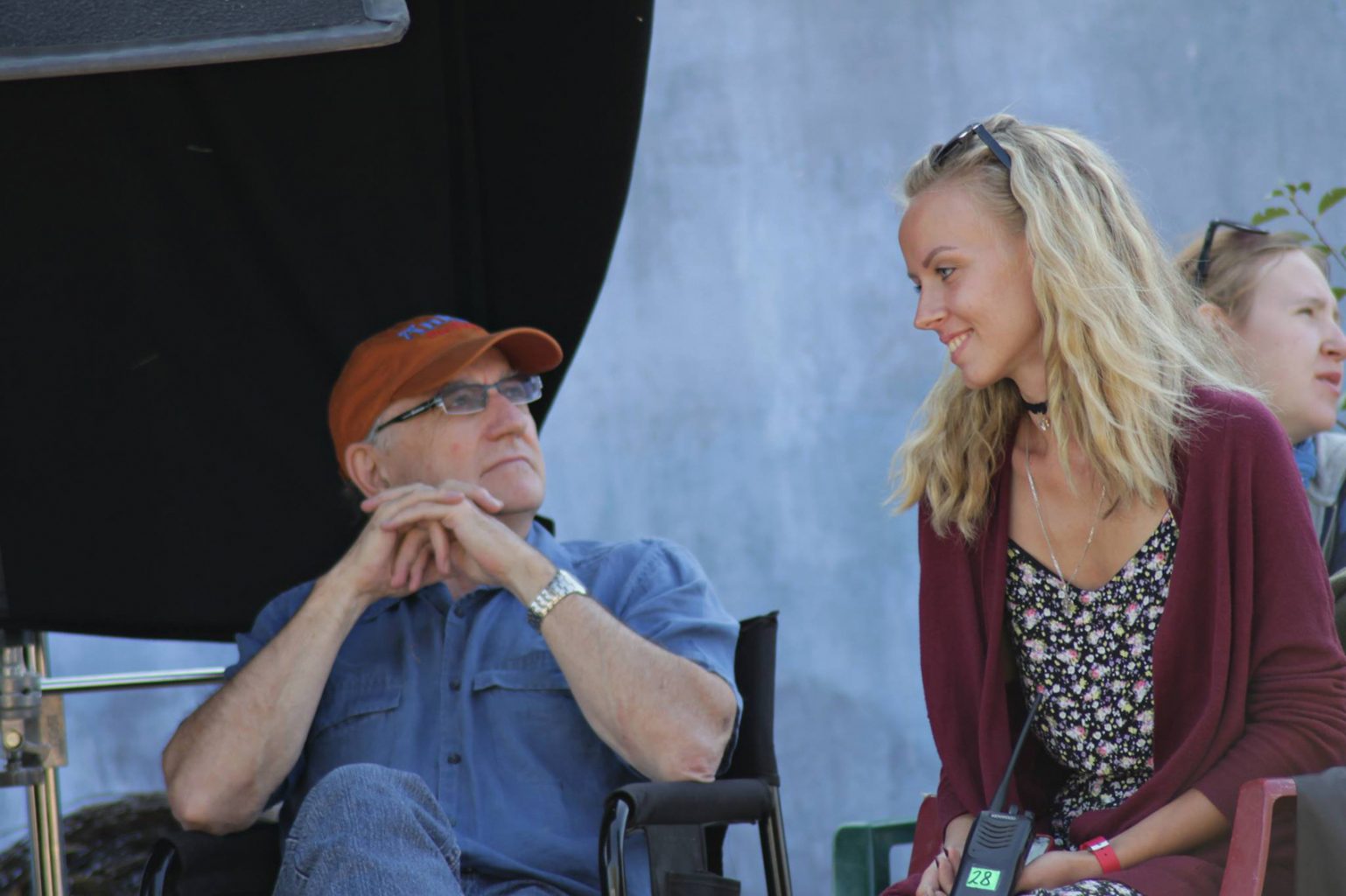 Eisler on the set of Anton, near Odessa, Ukriane. Production took place over six weeks in a village not far from where the events of 1919 unfolded.
“Having a director attached to a script — a director who is pretty well known, particularly in Europe — that gives you credibility,” Eisler explains. “It’s much tougher pitching a script in isolation. Having a producer who is interested is important, but having a director is the critical component.”
With Urushadze on board, Davitaia was able to arrange financing with government partners in Ukraine and Georgia to support the production. Finding bilingual actors was a challenge, since the film was shot using German and Russian dialogue, with English subtitles.
Production took place over six weeks in a village not far from where the events of 1919 unfolded. Eisler observed the production work for about a week, describing some of the scenery as breathtaking and praising the work of cinematographer Mikhail Petrenko. “He (Petrenko) has an eye for these sorts of things,” Eisler says.
Eisler on the set of Anton, near Odessa, Ukriane. Production took place over six weeks in a village not far from where the events of 1919 unfolded.
“Having a director attached to a script — a director who is pretty well known, particularly in Europe — that gives you credibility,” Eisler explains. “It’s much tougher pitching a script in isolation. Having a producer who is interested is important, but having a director is the critical component.”
With Urushadze on board, Davitaia was able to arrange financing with government partners in Ukraine and Georgia to support the production. Finding bilingual actors was a challenge, since the film was shot using German and Russian dialogue, with English subtitles.
Production took place over six weeks in a village not far from where the events of 1919 unfolded. Eisler observed the production work for about a week, describing some of the scenery as breathtaking and praising the work of cinematographer Mikhail Petrenko. “He (Petrenko) has an eye for these sorts of things,” Eisler says.